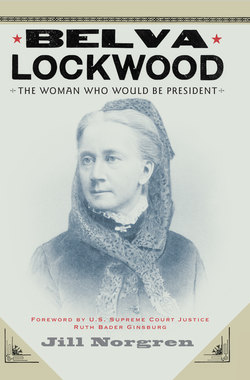Читать книгу Belva Lockwood - Jill Norgren - Страница 5
На сайте Литреса книга снята с продажи.
Foreword
ОглавлениеRuth Bader Ginsburg
Associate Justice, Supreme Court of the United States
In 1973, when I first appeared before the United States Supreme Court to present oral argument, nearly a century had elapsed since the Court first heard a woman’s voice at counsel’s lectern. At the start of the 1970s, law remained a dominantly male profession, but the closed door era had ended. Given the impetus of antidiscrimination legislation, women lawyers were beginning to appear in court as more than one-at-a-time curiosities. Principal among way pavers in days when women were not wanted at the bar was a brave pioneer named Belva Ann Lockwood.
In this meticulously researched and moving account, Professor Norgren has rescued Lockwood’s extraordinary story from relative obscurity. Once compared to Shakespeare’s Portia by her sister suffragist Elizabeth Cady Stanton [p. 74], Lockwood resembled Shakespeare’s character in this respect: Both were individuals of impressive intellect who demonstrated that women can hold their own as advocates for justice. Like Shakespeare’s Portia, Lockwood used wit, ingenuity, and sheer force of will to unsettle society’s conceptions of her sex. Portia, however, succeeded in her mission by impersonating a man. Lockwood, in contrast, used no disguise in tackling the prevailing notion that women and lawyering, no less politics, do not mix: She became the first woman admitted to the Bar of the Supreme Court, and she ran twice for the office of President of the United States. Her enduring legacy, however, is the path she opened for women who later followed the tracks she made.
Her front-runner status was achieved by persistent effort. In 1869, as a mother of two approaching her thirty-ninth birthday, Lockwood gained no easy entrance into what was then a nearly all-male profession. Initially denied a legal education on the ground that her presence “would be likely to distract the attention of the young men” [p. 41], she persevered until she found a law school willing to admit her. She encountered yet another obstacle when that school refused to issue the diploma she had earned.
Throughout her life, Lockwood continued to wear down barriers society placed in women’s way. When the U.S. Supreme Court refused to admit her to its Bar, she accelerated her efforts to persuade Congress to grant her plea. After years of lobbying, she gained passage of a bill that required the High Court to relent. In 1879, she became the first woman admitted to practice before the Supreme Court, and, twenty-one months later, the first woman to participate in oral argument at the Court. She next and last argued before the Court in 1906. Then age seventy-five, she helped to secure a multi-million dollar award for Cherokees who had suffered removal from their ancestral lands and relocation, without just compensation.
Lockwood was not content to rest on her personal achievements. She sought full political and civil rights for women and became a prominent leader in the suffrage movement. Though she could not vote for President, she ran for the office herself, pointing out that nothing in the Constitution barred a woman’s eligibility. As she wrote in a letter to her future running mate, Marietta Stow: “We shall never have equal rights until we take them, nor respect until we command it” [p. 129]. In 1884 and 1888, during her two campaigns as the presidential nominee of the Equal Rights Party, Lockwood drew attention to a range of issues important to Americans. For example, she urged protection of public lands, called for reform of family law, and advocated use of tariff revenues to fund benefits for Civil War veterans. She was an activist in the international peace movement and became a leading proponent of international arbitration.
So much has changed for the better since Belva Lockwood’s years in law practice. Admissions ceremonies at the Court nowadays include women in numbers. It is no longer unusual for women to represent both sides in the cases we hear. Women today serve as presidents of bar associations, federal judges, and elected representatives on the local, state, and federal level. Still, the presence of only one woman on the current High Court bench indicates the need for women of Lockwood’s sense and steel to see the changes she helped to inaugurate through to full fruition.
Professor Norgren deserves high commendation for recognizing Lockwood’s rightful place in United States history by writing this biography, the first for adult readers. Norgren’s effort is all the more impressive because so many of Lockwood’s personal papers have been destroyed. The story told in the following pages reminds us that ideas once taken as fixed can be changed. Resilience, wit, and good humor, Lockwood’s work and days reveal, can turn put-downs and slights into opportunities. With optimism and tenacity, may we continue to strive as she did to advance in our Nation and World the ideals of liberty, equality, and justice for all.
